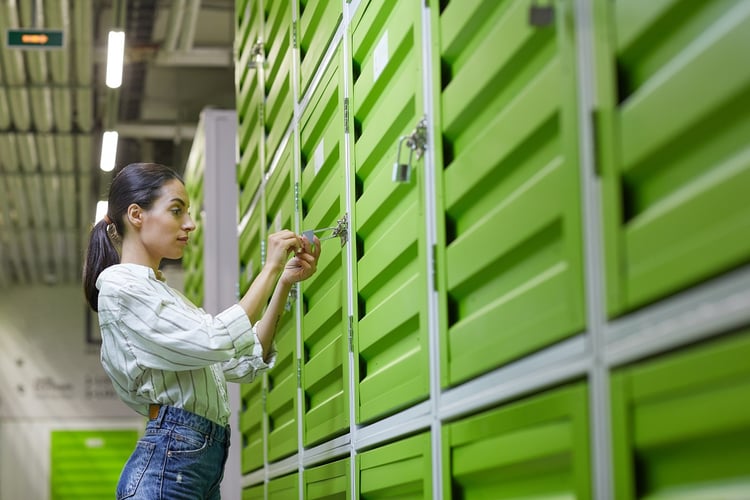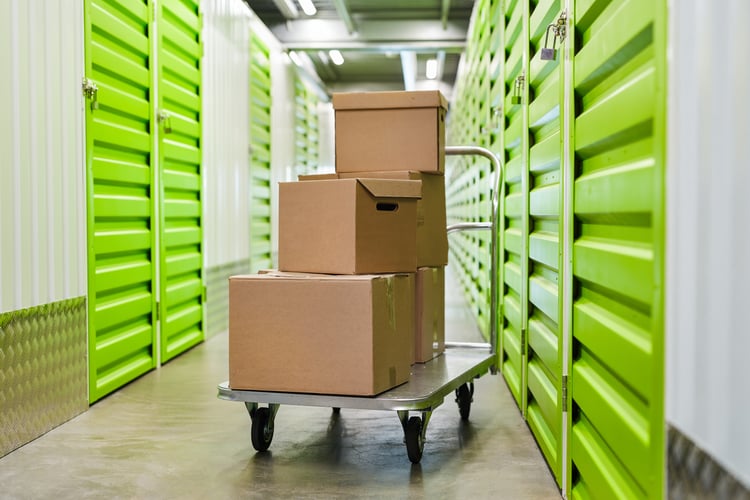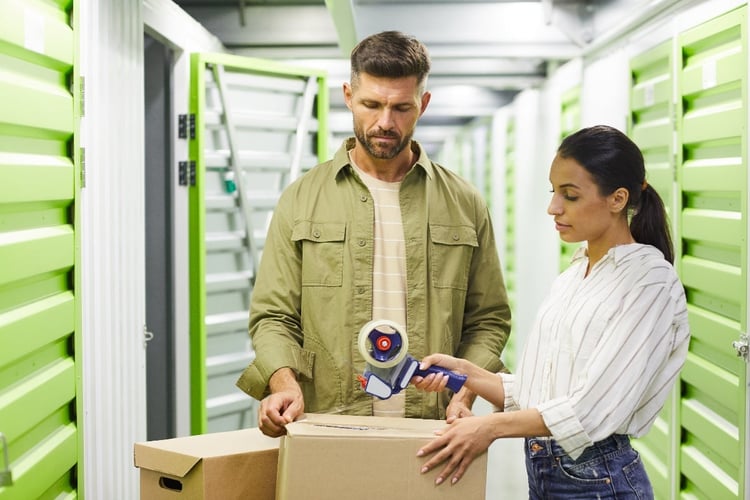Climate controlled self storage continues to gain in popularity as customers look for facilities with units that can house and preserve valuable, sensitive, and sentimental items by controlling temperature and humidity.
While climate controlled units may not work in every market or with every demographic, when they do make sense, climate controlled storage can benefit self storage owners. A climate controlled storage facility can bring in new customers and more money, while differentiating the facility from the competition. Of course, there are a number of considerations for building or converting climate controlled storage units, which we’ll look at in this blog.
The History of Climate Controlled Self Storage Buildings
Climate control in the self storage industry began gaining steam in the 1990s. Conventional sites on which to build self storage facilities were getting harder to find, and those that were available were pricey or in unsatisfactory locations. At the same time, big box stores like Wal-Mart, Kmart, and Home Depot, along with numerous grocery chains, were relocating from mid-size buildings to sprawling locations with more square footage in order to better handle their growing inventories. This resulted in many vacant buildings.
Always the entrepreneurs, self storage owners began snapping up the vacant buildings, converting them into self storage facilities. Of course, these vacant buildings already had existing heating and cooling systems, and the new owners decided to use this to their benefit to increase their revenue. While people in some markets were cornered into accepting climate controlled units and their premium price due to a lack of conventional self storage units in the area, other markets, such as the hot and humid southern states, were extremely welcoming to climate control. And thus, climate controlled self storage units were born!
6 Considerations of Climate Controlled Storage Units
Considering building, converting, or adding climate controlled storage units? Here are six things you’ll want to think about.
1. Design
Single-story or multistory building designs are equally suitable for climate control. While a one-story facility only has one air conditioning output level to consider, in a two-story site you may need greater A/C output on the second level as it will gain heat from the roof that the bottom level will not. For buildings with three or more stories, the middle floors will require less A/C output, as the cooled air will spread through several floors. Be sure to work with a knowledgeable contractor who understands that not all floors will need the same A/C loads.

2. Demand
Just how in demand are climate controlled storage units in your area? A feasibility study should help determine this by analyzing the competition, consumer/business mix, and disposable income levels. Of course, just because the competition doesn’t offer climate controlled storage units doesn’t mean you shouldn’t – if the market is ripe for them, this could be a great point of differentiation.
Of course, people with higher disposable income are more likely to spend the additional money on a climate controlled storage unit, while facilities in business areas have strong storage demand for items such as records, furniture, fixtures, and retail inventory. Locations that are accessible to highly traveled roads or freeways are also valuable to salespeople, who may need to store samples (think cosmetics and pharmaceuticals), vending supplies, and semi-perishables in climate controlled storage units.

You may also look at how many long-term tenants you have or anticipate having. People who store their belongings across multiple seasons or for more than a year or longer will understand that the temperatures will likely vary quite wildly in that time, going to extremes. This may make them more willing to pay a climate control premium.
3. Cost
When costing out a climate control build, you’ll need to factor in the cost of the HVAC mechanical system and the extra insulation you’ll need. You can expect to pay about $60-$70 per square foot to build a non-climate controlled self-storage facility (multistory self-storage units typically cost $70-$95 per square foot). When costing out a climate controlled storage unit build, a good rule of thumb is to add 15% to each square foot or to the total cost.
|
Facility Type |
Square Footage |
Cost per Square Foot |
Total |
|
Regular one-story build |
50,000 |
$65.00 |
$3,250,000 |
|
Climate control one-story build |
50,000 |
$28.75 |
$3,737,500 |
Remember, the cost for either facility can vary greatly. For instance, the cost of steel may go up or down at any given time, or the area where you’re building the facility may be experiencing a labor shortage. And, of course, you’ll certainly face higher costs in a major metro area than you would in a small community for a climate controlled storage facility.
Also, remember that monthly utility costs will be greater for climate controlled storage units. However, these costs will go down as capacity increases; as your facility begins to fill up with tenants’ goods, the cubic feet of free air space is reduced significantly, creating less of a draw on the air-conditioning system.

According to Statista storage statistics, the average cost of a regular 10x20 unit is about $190, while the average cost of a climate controlled unit is $255. That’s more than a 25% increase in revenue. So, it won’t take long to offset the additional costs of the build and utilities.
4. Insulation
Most self-storage exterior walls contain long rows of metal doors. These doors are not air-tight, which presents a challenge containing heat or cooling. So, be sure to design your climate control units with fully insulated interior walls and roofing. The few bucks you save on inadequate insulation will quickly be lost to the added cost of increased heating and air conditioning.
Inside Self Storage recommends a minimum of 6 inches of fiberglass (R 19) for roofs and walls. The building’s heat loss and gain must be determined by the HVAC contractor, who will calculate insulation values, ceiling heights, cubic area, type of construction, amount of lighting, exterior doors, number of windows, and the air infiltration from outside. Make sure your contractor also understands commercial insulation requirements imposed by the International Energy Conservation Council (IECC) which are designed to preserve energy.
5. Temperature
Climate control units generally maintain a temperature below 85 degrees in the summer and above 55 degrees in the winter, with humidity below 65% to stop mold or mildew. It’s a common myth that you must maintain about 72 degree temperatures year-round; this is unnecessary and expensive. That temperature is meant for human comfort, but it’s not necessary for items in storage.

6. HVAC systems
Be sure that you and your contractor or self storage consultant research the costs and efficiencies of various heating and cooling units to decide which is best for your facility and immediate or long-term needs. You’ll want to weigh the pros and cons of lower-priced units with less efficiency that will save you money in the short-term vs. higher-priced units with greater efficiency that will save you money over time. You’ll also want to identify HVAC systems that have a separate humidistat for reducing humidity. On high-efficiency units, a circulating fan should run continuously to circulate the air throughout the entire building.
Benefits of Climate Control Units
New Customers
Offering some climate control units can bring in a more diverse range of tenants, potentially reducing the financial risk of appealing only to one demographic. It can also be a draw for those who never used self storage because they were concerned about protecting their belongings from the elements. Check out our blog on the 12 people most likely to use storage units; when reading through it, think about your current or potential clientele and whether they would be likely to pay a premium for climate control.

Competitive Advantage
Simply put, if there’s a market for climate control units in your area and the competition isn’t offering them as an option, you’ll be at an advantage when it comes to attracting those who put a price on A/C, heating, and humidity control in order to keep their belongings in the same condition as when they were stored. Once you reel them in, they’re also more likely to become long-term tenants since there isn’t another climate-controlled facility in the area that they can easily move their items to if rent increases, etc. Be sure to always highlight your climate controlled unit options in your marketing and advertising efforts and provide education on what should be kept in a climate control unit and why (see the following section for more on this). Consider outreach efforts to professionals, business owners, and sales representatives as well since they are good candidates for climate control units.
Extra Revenue
As previously discussed, climate control units can bring in, on average, 25% more money than those without the amenity. If you’re going to be converting some existing units to climate control units, you can also increase the rent once the tenant understands the benefits of climate control. If you encounter resistance to price increases due to climate control, consider value-based pricing. For example, you might discount the units farther from the entrance or elevator to provide a discount to those who are price-sensitive and raise rates on better-located units for those who want to pay for that convenience.
Items That Need Climate Control Units
Here’s a list of items that can greatly benefit from climate control. Be sure to list these items on your website to help people decide whether or not they want to pay a premium to store their goods.

- Furniture and other items made out of wood, metal, wicker, or leather
- Clothing, especially clothing made out of lace or leather
- Media such as DVDs, videos, vinyl records, etc.
- Collectibles such as stamps, coins, comic books, etc.
- Medical supplies and medications
- Makeup and toiletries
- Important documents
- Photographs
- Artwork
- Antiques
- Wine
- Household appliances
- Musical instruments
- Sports equipment including bicycles
Be sure to explain why these items will benefit from a climate control unit. You can mention that without climate/moisture control, wood can become warped, cracked, or rotted; leather can become discolored and is susceptible to mold and mildew; electronics can become cracked or rusted, and paper (including photographs) can become illegible or may actually begin to disintegrate.
Learn More About Climate Controlled Storage with Storelocal Consulting
Climate-controlled storage continues to be sought after by customers and developers alike. While it’s more expensive to build them, climate control units can be a great asset for self-storage owners, providing additional revenue and competitive advantage while attracting new tenants.

Want to learn more about climate-controlled storage units? Join Storelocal. We are a community of independent self-storage owners and operators who have come together to increase our competitive advantage in the marketplace, leveraging new and existing resources to lower our operational costs and increase profits! As a member or prospective member, you can also gain valuable insights about climate control solutions and more through Storelocal Consulting.
